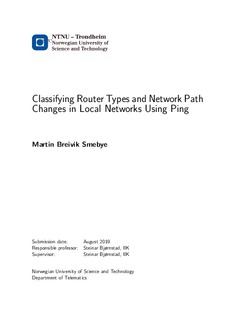| dc.description.abstract | Da ping ble skrevet i 1983, ble det hovedsaklig sett på som et verktøy for å estimere avstanden mellom klienten som kjørte programmet, og en annen node i nettverket klienten var koblet til. Siden den gang har Internet Engineering Task Force spesifisert at alle nettverksverter må implementere funksjonalitet for å motta og svare på ping pakker, som gjør ping til et meget tilgjengelig verktøy. Ved å måle tiden det tar fra man sender en pakke til man mottar det korresponderende svaret får man en indikasjon på hvor langt det er fra klienten og svareren. Sammen med å måle pakketap for å få et innblikk nettverkstrafikken har dette vært hovedbruken til ping. I denne oppgaven ser vi på nye bruksområder for ping.
Ved å samle inn måledata og anvende analyseredskapene våre i en serie eksperimenter vil vi utforske pings egnethet til å oppdage små endringer i lokale nettverk, samt ets egnethet til klassifisering av rutere ved å se på serier av ping-svar. For å analysere dataen vår har vi brukt signalprosessering og \textit{deep learning}. Signalprosessering er et veletablert felt innen ingeniørvitenskap som fokuserer på å analysere, modifisere og syntetisere signaler. Deep learning er en type maskinlæring, som igjen er en fremgangsmåte under kunstig intelligens. I tillegg til å vurdere pings egnethet for våre satte utfordringer vil denne oppgaven også vurdere egnetheten til de to analysemetodene. | |
| dc.description.abstract | When ping was written in 1983, it was seen as a tool for estimating the distance between the client running the program, and another node in a network the client was connected to. Since pings inception, the Internet Engineering Task Force has specified that all hosts in the internet has to implement functionality for receiving and responding to ping package, making it widely available. By measuring the time it takes from a client sends a packet, until it receives the corresponding response, you are given an indication of the distance between the client and the responder. This, along with measuring the perceived traffic along the network path by looking at packet loss, has been the main application of the ping program. In this thesis we explore additional applications of the ping program.
By gathering measurements and applying our analysis tools in a series of experiments, we examine pings capabilities to detect small changes in local networks, and its capacity to classify router types by looking at series of their ping responses. To analyse our data we have utilised two different methods, Signal Processing and deep learning. Signal Processing is a well established field in engineering that focuses on analysing, modifying and synthesising signals. Deep learning is a type of machine learning, which is an approach to Artificial Intelligence. In addition to evaluating the capabilities of ping for our set tasks, this thesis also discusses the practicality of these two methods. | |
